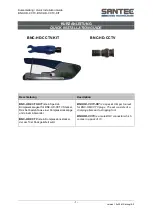
Using Your Rip-Cut
™
Assembly
Step 7: Align the Cursor and Determine the Narrowest Cut
Rotate the saw blade guard up and slide the sled
(E)
along the rail
(C)
until the blade just touches the edge guide
(A)
. Lock the sled
in place by pressing down on the handle
(M)
. The handle does not
need to be completely horizontal to lock securely. Press down on
the cursor lock and align the red cursor
(K)
with the zero mark on
the rail scale. The minimum safe cut may be greater than 1″.
K
Red Line of cursor
E
A
C
!
WARNING
On the scale, the area between zero and 1″ [25mm] is
marked
Not Recommended, See Manual
. On most saws, the edge guide
interferes with blade-guard operation on cuts of less than 1″ [25mm], so these
cuts should not be attempted. After aligning the cursor, verify the minimum safe
cut width by moving the sled away from the edge guide until the blade guard
functions without interference.
1) For the best results, install a 40-tooth blade or better on your saw.
2) With the saw mounted on the sled, adjust the depth of cut so the
blade will protrude ⅛″ [3mm] through the workpiece during the cut.
3) Release the wedge lock and slide the sled along the rail until the
cursor aligns with the desired dimension on the scale.
Engage the wedge lock.
4) Completely support the workpiece and cutoff with
2x4s or 2″ [50mm]-thick rigid foam insulation laid flat on the floor.
5) Connect your saw to power. With one hand on the edge guide
and the other holding the saw, press the edge guide against the edge
of your workpiece and make your cut, moving the edge guide and
saw forward at the same speed throughout the entire cut. Allow
the saw blade to come to a complete stop before lifting the
Rip-Cut
™
from the workpiece.
!
WARNING
When making narrow cuts, make sure the hand holding
the edge guide does not contact the blade.
M
Summary of Contents for Rip-Cut KMA2685
Page 11: ...Notes ...






























